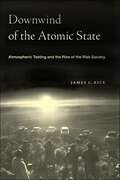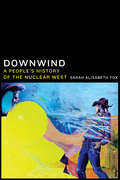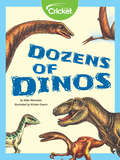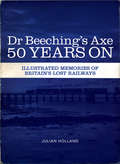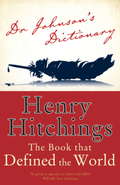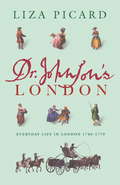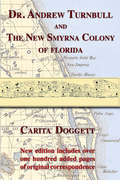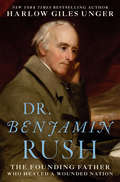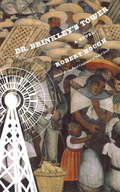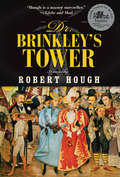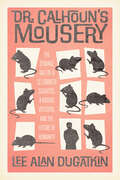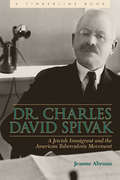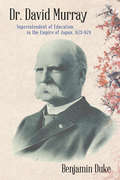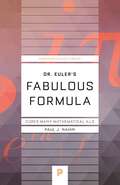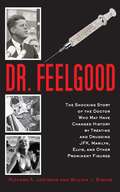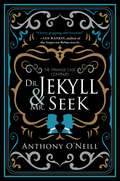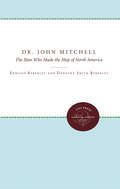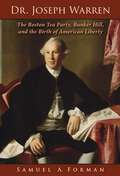- Table View
- List View
Downwind of the Atomic State: Atmospheric Testing and the Rise of the Risk Society
by James C. Rice2024 Outstanding Academic Title, given by Choice ReviewsHow the scientific community overlooked, ignored, and denied the catastrophic fallout of decades of nuclear testing in the American WestIn December of 1950, President Harry Truman gave authorization for the Atomic Energy Commission to conduct weapons tests and experiments on a section of a Nevada gunnery range. Over the next eleven years, more than a hundred detonations were conducted at the Nevada Test Site, and radioactive debris dispersed across the communities just downwind and through much of the country. In this important work, James C. Rice tells the hidden story of nuclear weapons testing and the negligence of the US government in protecting public health.Downwind of the Atomic State focuses on the key decisions and events shaping the Commission’s mismanagement of radiological contamination in the region, specifically on how the risks of fallout were defined and redefined, or, importantly, not defined at all, owing to organizational mistakes and the impetus to keep atomic testing going at all costs. Rice shows that although Atomic Energy Commission officials understood open-air detonations injected radioactive debris into the atmosphere, they did not understand, or seem to care, that the radioactivity would irrevocably contaminate these communities.The history of the atomic Southwest should be a wake-up call to everyone living in a world replete with large, complex organizations managing risky technological systems. The legacy of open-air detonations in Nevada pushes us to ask about the kinds of risks we are unwittingly living under today. What risks are we being exposed to by large organizations under the guise of security and science?
Downwind: A People's History of the Nuclear West
by Sarah Alisabeth FoxDownwind is an unflinching tale of the atomic West that reveals the intentional disregard for the inhabitants and the environment in nuclear testing by the federal government and in uranium extraction by mining corporations during and after the Cold War. Sarah Alisabeth Fox interviews residents of the Great Basin region effected by environmental contamination from the uranium industry and nuclear testing fallout. Those residents tell tales of communities ravaged by cancer epidemics, farmers and ranchers economically ruined by massive crop and animal deaths, and Native miners working in dangerous conditions without proper safety equipment so that the government could surreptitiously study the effects of radiation on humans. In chilling detail, Downwind brings to light the stories and concerns of these groups whose voices have been silenced and marginalized for decades in the name of “patriotism” and “national security.” With the renewed boom in mining in the American West, Fox’s look at this hidden history, unearthed from years of field interviews, archival research, and epidemiological studies, is a must-read for every American concerned about the fate of our western lands and communities.
Doxology: A Novel
by Nell ZinkNamed a Best Book of the Year by:The New York Times * New York Magazine * Lit Hub * TIME * O, the Oprah Magazine * Good HousekeepingTwo generations of an American family come of age—one before 9/11, one after—in this moving and original novel from the “intellectually restless, uniquely funny” (New York Times Book Review) mind of Nell ZinkPam, Daniel, and Joe might be the worst punk band on the Lower East Side. Struggling to scrape together enough cash and musical talent to make it, they are waylaid by surprising arrivals—a daughter for Pam and Daniel, a solo hit single for Joe. As the ‘90s wane, the three friends share in one another’s successes, working together to elevate Joe’s superstardom and raise baby Flora.On September 11, 2001, the city’s unfathomable devastation coincides with a shattering personal loss for the trio. In the aftermath, Flora comes of age, navigating a charged political landscape and discovering a love of the natural world. Joining the ranks of those fighting for ecological conservation, Flora works to bridge the wide gap between powerful strategists and ordinary Americans, becoming entangled ever more intimately with her fellow activists along the way. And when the country faces an astonishing new threat, Flora’s family will have no choice but to look to the past—both to examine wounds that have never healed, and to rediscover strengths they have long forgotten.At once an elegiac takedown of today’s political climate and a touching invocation of humanity’s goodness, Doxology offers daring revelations about America’s past and possible future that could only come from Nell Zink, one of the sharpest novelists of our time.
Dozens of Dinos
by Mike Weinstein Kirsten GuerinHave you ever wondered what it would be like to stand next to a real dinosaur? Millions of years ago, Dinosaurs ruled the earth and left their fossils behind for us to find all over the world. These fossils help archaeologists and paleontologists learn about what dinosaurs may have looked like. Some were really big and some were really small. In this story, you will learn all of the different shapes & sizes of your favorite dinosaurs before they went extinct. How will you measure up next to your favorite dinosaur?
Dr Beeching's Axe 50 Years On
by Julian HollandJulian Holland's Dr Beeching's Axe 50 Years On is a unique memorial to all that was lost following the publication of the 'Beeching Report' on 27 March 1963. Uniquely, the author has tried to include every railway line that was closed as a result of the 'Beeching Report', and more. They are all shown on Map 9 in Part 2 of the 'Report' and have been annotated for clarity at the beginning of each regional chapter in the book. Needless to say it is not plain sailing: there are lines that were marked for closure on the maps but were closed before publication of the 'Report'; there are lines that were not originally on Beeching's original hit list but which were closed anyway; there are lines that were originally marked down for closure but which were fortunately reprieved. There are even one or two which seem to have not existed at all! The author has included them all.
Dr Johnson's Dictionary: The Book that Defined the World
by Henry HitchingsBy 1700, France and Italy already had dictionaries of their own, and it became a matter of national pride that England should rival them. Dr Johnson rose to the challenge, turning over the garret of his London home to the creation of his Dictionary. He imagined it would take three years. Eight years later it was finally published, full of idiosyncrasies, but complete nevertheless. It would become the most important British cultural monument of the eighteenth century. This is the story of Johnson's attempt to define each and every word. In wonderfully engaging chapters, Hitchings describes Johnson's adventure - his ambition and vision, his moments of despair, the mistakes he made along the way and his ultimate triumph.
Dr Johnson's London (Life of London #3)
by Liza Picard'A Baedeker of the past, absorbing and revealing in equal measure' Peter Ackroyd'Brings the age's tortuous splendours and profound murkiness vividly to life' ObserverWhen Dr Johnson published his great Dictionary in 1755, London was the biggest city in Europe. The opulence of the rich and the comfort of the 'middling' sort contrasted sharply with the back-breaking labour and pitiful wages of the poor. Executions were rated one of the best amusements, but there was bullock-hunting and cock-fighting too. Crime, from pickpockets to highwaymen, was rife, prisons were poisonous and law-enforcement rudimentary.Dr Johnson's London is the result of the author's passionate interest in the practical details of the everyday life of our ancestors: the streets, houses and gardens; cooking, housework, laundry and shopping; clothes and cosmetics; medicine, sex, hobbies, education and etiquette. The book spans the years 1740 to 1770, starting when the gin craze was gaining ground and ending when the east coast of America was still British. While brilliantly recording the strangeness and individuality of the past, Dr Johnson's London continually reminds us of parallels with the present day.
Dr Johnson's London (Life of London #3)
by Liza PicardLike its popular and acclaimed predecessor RESTORATION LONDON, this book is the result of the author's passionate interest in the practical details of the everyday life of our ancestors, so often ignored in more conventional history books. Based on every possible contemporary source - diaries, almanacs, newspapers, advice books, memoirs, government papers and reports - Liza Picard examines every aspect of life in London: the streets, houses and gardens; cooking, housework, laundry and shopping; clothes and jewellery, cosmetics and hairdressing; medicine, sex, hobbies, education and etiquette; religion and popular beliefs; law and crime. This book spans the years 1740 to 1770, starting when the gin craze was gaining ground and ending when the east coast of America was still British.`Accessible and vivid. Picard's curiosity and enthusiasm are infectious, and she has an instinct for what will interest the lay reader' Daily TelegraphRead by Fiona Shaw(p) 2000 Orion Publishing Group
Dr Johnson's London: Everyday Life In London In The Mid 18th Century
by Liza Picard'A Baedeker of the past, absorbing and revealing in equal measure' Peter Ackroyd'Brings the age's tortuous splendours and profound murkiness vividly to life' ObserverWhen Dr Johnson published his great Dictionary in 1755, London was the biggest city in Europe. The opulence of the rich and the comfort of the 'middling' sort contrasted sharply with the back-breaking labour and pitiful wages of the poor. Executions were rated one of the best amusements, but there was bullock-hunting and cock-fighting too. Crime, from pickpockets to highwaymen, was rife, prisons were poisonous and law-enforcement rudimentary.Dr Johnson's London is the result of the author's passionate interest in the practical details of the everyday life of our ancestors: the streets, houses and gardens; cooking, housework, laundry and shopping; clothes and cosmetics; medicine, sex, hobbies, education and etiquette. The book spans the years 1740 to 1770, starting when the gin craze was gaining ground and ending when the east coast of America was still British. While brilliantly recording the strangeness and individuality of the past, Dr Johnson's London continually reminds us of parallels with the present day.
Dr Johnson's Women
by Norma ClarkeDr Johnson's friendships with the leading women writers of the day was an important feature of his life and theirs. He was willing to treat women as intellectual equals and to promote their careers: something ignored by his main biographer, James Boswell. Dr Johnson's Women investigates the lives and writings of six leading female authors Johnson knew well: Elizabeth Carter, Charlotte Lennox, Elizabeth Montagu, Hester Thrale, Hannah More and Fanny Burney. It explores their relationships with Johnson, with each other and with the world of letters. It shows what it was like to be a woman writer in the 'Age of Johnson'. It is often assumed that women writers in the eighteenth century suffered the same restrictions and obstacles that confronted their Victorian successors. Norma Clarke shows that this was by no means the case. Highlighting the opportunities available to women of talent in the eighteenth century, Dr Johnson's Women makes clear just how impressive and varied their achievements were.
Dr. Andrew Turnbull and The New Smyrna Colony of Florida
by Carita DoggettWhen East Florida was ceded to England by Spain in 1763, Scottish physician, Dr. Andrew Turnbull, recruited over 1,400 Mediterranean colonists to establish the agricultural colony he named "Smyrnéa." Carita Doggett recounts that not only did the growing conditions prove less than ideal but how seemingly every imaginable calamity befell the colony before it failed in 1777. his edition of Dr. Andrew Turnbull and The New Smyrna Colony of Florida includes dozens of letters between Andrew Turnbull and others involved with his Smyrnéa venture. These documents, not available to Carita Doggett, were discovered in the tower of Ballindalloch Castle in Scotland where they had been archived for centuries. This diary-like correspondence brings to life the dreams, efforts, and trials of Andrew Turnbull and the Smyrna colonists.
Dr. B.: A Novel
by Daniel BirnbaumThe former director of the Museum of Modern Art in Stockholm makes his literary debut with this dramatic and riveting novel of book publishing, émigrés, spies, and diplomats in World War II Sweden based on his grandfather’s life.In 1933, after Hitler and the Nazi Party consolidated power in Germany, Immanuel Birnbaum, a German Jewish journalist based in Warsaw, is forbidden from writing for newspapers in his homeland. Six years later, just months before the German invasion of Poland that ignites World War II, Immanuel escapes to Sweden with his wife and two young sons.Living as a refugee in Stockholm, Immanuel continues to write, contributing articles to a liberal Swiss newspaper in Basel under the name Dr. B. He also begins working as an editor for the legendary German publisher S. Fischer Verlag. Gottfried Bermann Fischer had established an office in Stockholm to evade German censorship, publishing celebrated German writers such as Thomas Mann and Stefan Zweig.Immanuel also becomes entangled with British intelligence agents who produce and distribute anti-Nazi propaganda in Stockholm. On orders from Winston Churchill, the Allied spies plan several acts of sabotage. But when the Swedish postal service picks up a letter written in invisible ink, the plotters are exposed. The letter, long a mystery in military history accounts, was in fact written by Dr. B. But why would a Jew living in exile and targeted for death by the Nazis have wanted to tip them off? Daniel Birnbaum’s novel will intrigue readers with its fascinating portrayal of the astonishing connections and often mysterious players illuminated by his grandfather’s remarkable wartime life.
Dr. Benjamin Rush: The Founding Father Who Healed a Wounded Nation
by Harlow Giles UngerA gripping, often startling biography of the Founding Father of an America that other Founding Fathers forgot--an America of women, African Americans, Jews, Roman Catholics, Quakers, indentured workers, the poor, the mentally ill, and war veteransNinety percent of Americans could not vote and did not enjoy rights to life, liberty, or the pursuit of happiness when our Founding Fathers proclaimed, "all men are created equal." Alone among those who signed the Declaration of Independence, Benjamin Rush heard the cries of those other, deprived Americans and stepped forth as the nation's first great humanitarian and social reformer.Remembered primarily as America's leading, most influential physician, Rush led the Founding Fathers in calling for abolition of slavery, equal rights for women, improved medical care for injured troops, free health care for the poor, slum clearance, citywide sanitation, an end to child labor, free universal public education, humane treatment and therapy for the mentally ill, prison reform, and an end to capital punishment. Using archival material from Edinburgh, London, Paris, and Philadelphia, as well as significant new materials from Rush's descendants and historical societies, Harlow Giles Unger's new biography restores Benjamin Rush to his rightful place in American history as the Founding Father of modern American medical care and psychiatry.
Dr. Brinkley's Tower
by Robert HoughA riotous tale of love and lust, valor and villainy on the Mexican frontier of the 1930s.Robert Hough's vivid and wildly imaginative novel takes us to 1931 Mexico and Corazón de la Fuente, a war-ravaged border town where the only enterprise is a brothel in which every girl is called Maria. Enter, from north of the border, Dr. Romulus Brinkley, inventor of a miraculous "goat gland operation" said to cure sexual impotence. When Brinkley decides to build a gargantuan new radio tower to broadcast his services throughout the United States, he chooses none other than Corazón de la Fuente for its site. The town's fortunes change overnight, but not all to the good - word of the new prosperity spreads, and Corazón is overrun with desperadoes and mercenaries itching to reopen old wounds. Worst of all, Dr. Brinkley has attracted the affections of the town's most beautiful citizen, Violeta Cruz. But with the help of a motley band of allies, Violeta's spurned fiancé, Francisco, decides to fight back.Inspired by the monstrous shenanigans of a real life American con man and peopled with unforgettable characters, Dr. Brinkley's Tower captures a young Mexico caught between its own ambitions and the designs of its wealthier neighbor to the north.From the Trade Paperback edition.
Dr. Brinkley's Tower
by Robert HoughLonglisted for the Scotiabank Giller Prize and shortlisted for the Governor General's Literary Award: Fiction Bonus e-book content includes two out-takes from the novel -- how Antonio Garcia got his beautiful horse and how Miguel Orozco became mayor -- and two essays by Robert Hough: the true history of Dr. Brinkley and Robert Hough's decades-long infatuation with Mexico. Equal parts Mark Twain and Gabriel García Márquez, Robert Hough's wildly imaginative new novel takes us to 1931 and Corazon de la Fuente, a tiny Mexican border town where the only industry is a run-down brothel. Enter Dr. Romulus Brinkley and his gargantuan radio tower, built to broadcast his revolutionary goat-gland fertility operation. Fortunes in Corazon change overnight, but not all for the good. Word of the new prosperity spreads, and the town is overrun by the impoverished, the desperate, and the flat-out criminal. The tower's frequencies are so powerful the whole area glows green, and the signal is soon broadcasting through every bit of metal it can find: fencing wire, toasters, even a young woman's new braces. Meanwhile, Dr. Brinkley has attracted the affections of Violeta Cruz, Corazon’s most beautiful resident. But is he really all that he seems? Peopled with unforgettable characters and capturing a young Mexico caught between its own ambitions and the imperialist designs of its neighbor to the north, Dr. Brinkley’s Tower is a stunning achievement in storytelling.
Dr. Calhoun's Mousery: The Strange Tale of a Celebrated Scientist, a Rodent Dystopia, and the Future of Humanity
by Lee Alan Dugatkin“Brilliant. . . . An absorbing read and a potent lesson in moral behavior—both of rodents and of humans.”—Deborah Blum, Pulitzer Prize–winning author of The Poison Squad • “A fascinating read about an immensely influential scientist.”—Robert M. Sapolsky, author of the New York Times–bestseller Determined • “Stimulating scientific history. . . . Colorful accounts. . . . This fascinates.”—Publishers Weekly A bizarre and compelling biography of a scientist and his work, using rodent cities to question the potential catastrophes of human overpopulation. It was the strangest of experiments. What began as a utopian environment, where mice had sumptuous accommodations, had all the food and water they could want, and were free from disease and predators, turned into a mouse hell. Science writer and animal behaviorist Lee Alan Dugatkin introduces readers to the peculiar work of rodent researcher John Bumpass Calhoun. In this enthralling tale, Dugatkin shows how an ecologist-turned-psychologist-turned-futurist became a science rock star embedded in the culture of the 1960s and 1970s. As interest grew in his rodent cities, Calhoun was courted by city planners and his work was reflected in everything from Tom Wolfe’s hard-hitting writing to the children’s book Mrs. Frisby and the Rats of NIMH. He was invited to meetings with the Royal Society and the pope and taken seriously when he proposed a worldwide cybernetic brain—a decade before others made the internet a reality. Readers see how Calhoun’s experiments—rodent apartment complexes like “Mouse Universe 25”—led to his concept of “behavioral sinks” with real effects on public policy discussions. Overpopulation in Calhoun’s mouse (and rat) complexes led to the loss of sex drive, the absence of maternal care, and a class of automatons that included “the beautiful ones,” who spent their time grooming themselves while shunning socialization. Calhoun—and those who followed his work—saw the collapse of this mouse population as a harbinger of the ill effects of an overpopulated human world. Drawing on previously unpublished archival research and interviews with Calhoun’s family and former colleagues, Dugatkin offers a riveting account of an intriguing scientific figure. Considering Dr. Calhoun’s experiments, he explores the changing nature of scientific research and delves into what the study of animal behavior can teach us about ourselves.
Dr. Charles David Spivak: A Jewish Immigrant and the American Tuberculosis Movement (Timberline Books)
by Jeanne AbramsPart biography, part medical history, and part study of Jewish life in turn-of-the-century America, Jeanne Abrams's book tells the story of Dr. Charles David Spivak - a Jewish immigrant from Russia who became one of the leaders of the American Tuberculosis Movement. Born in Russia in 1861, Spivak immigrated to the United States in 1882 and received his medical degree from Philadelphia's Jefferson Medical College by 1890. In 1896, his wife's poor health brought them to Colorado. Determined to find a cure, Spivak became one of the most charismatic and well-known leaders in the American Tuberculosis Movement. His role as director of Denver's Jewish Consumptives' Relief Society sanatorium allowed his personal philosophies to strongly influence policies. His unique blend of Yiddishkeit, socialism, and secularism - along with his belief in treating the "whole" patient - became a model for integrating medical, social, and rehabilitation services that was copied across the country. Not only a national leader in the crusade against tuberculosis but also a luminary in the American Jewish community, Dr. Charles Spivak was a physician, humanitarian, writer, linguist, journalist, administrator, social worker, ethnic broker, and medical, public health, and social crusader. Abrams's biography will be a welcome addition to anyone interested in the history of medicine, Jewish life in America, or Colorado history.
Dr. David Murray: Superintendent of Education in the Empire of Japan, 1873-1879
by Benjamin DukeThis is the first biography in English of an uncommon American, Dr. David Murray, a professor of mathematics at Rutgers College, who was appointed by the Japanese government as Superintendent of Education in the Empire of Japan in 1873. The founding of the Gakusei—the first public school system launched in Japan—marks the beginning of modern education in Japan, accommodating all children of elementary school age. Murray’s unwavering commitment to its success renders him an educational pioneer in Japan in the modern world. Benjamin Duke has compiled this comprehensive biography of David Murray to showcase Murray’s work, both in assisting around 100 samurai students in their studies at Rutgers, and in his unprecedented role in early Japanese-American relations. This fascinating story uncovers a little-known link between Rutgers University and Japan, and it is the only book to conclude that Rutgers made a greater contribution to the development of modern education in the early Meiji Era than any other non-Japanese college or university in the world.
Dr. Euler's Fabulous Formula: Cures Many Mathematical Ills (Princeton Science Library #52)
by Paul J. NahinIn the mid-eighteenth century, Swiss-born mathematician Leonhard Euler developed a formula so innovative and complex that it continues to inspire research, discussion, and even the occasional limerick. Dr. Euler's Fabulous Formula shares the fascinating story of this groundbreaking formula—long regarded as the gold standard for mathematical beauty—and shows why it still lies at the heart of complex number theory. In some ways a sequel to Nahin's An Imaginary Tale, this book examines the many applications of complex numbers alongside intriguing stories from the history of mathematics. Dr. Euler's Fabulous Formula is accessible to any reader familiar with calculus and differential equations, and promises to inspire mathematicians for years to come.
Dr. Fager (Thoroughbred Legends #2)
by Steve HaskinDr. Fager was one of the most versatile and talented racehorses of modern times. In 1968, he recorded what many believe to be the single greatest season by any horse in the history of the sport. By being named Horse of the Year, champion handicap horse, champion sprinter, and co-champion grass horse in 1968, Dr. Fager became the first and only horse ever to win four titles in a single year. Author Steve Haskin recounts Dr. Fager's most memorable exploits: his world-record mile of 1:32 1/5, under 134 pounds, which lasted twenty-nine years; his seven furlong track record of 1:20 1/5 at Aqueduct, under a staggering 139 pounds, which lasted thirty-one years; and his equaling of the track record in the Suburban Handicap at Aqueduct for one and a quarter miles under 132 pounds. Each of The Doc's races was a study in greatness, whether it was sprinting, racing a distance of ground, or racing on the turf. Although his records finally have fallen, there is no doubt that the hole Dr. Fager ran in the wind ever will be filled. He remains one of the most popular racehorses of the modern era. Dr. Fager was ranked No. 6 in The Blood-Horse magazine's list of the Top 100 Racehorses of 20th Century.
Dr. Feelgood: The Shocking Story of the Doctor Who May Have Changed History by Treating and Drugging JFK, Marilyn, Elvis, and Other Prominent Figures
by William J. Birnes Richard A. LertzmanDoctor Max Jacobson, whom the Secret Service under President John F. Kennedy code-named “Dr. Feelgood,” developed a unique “energy formula” that altered the paths of some of the twentieth century’s most iconic figures, including President and Jackie Kennedy, Marilyn Monroe, Frank Sinatra, and Elvis. JFK received his first injection (a special mix of “vitamins and hormones,” according to Jacobson) just before his first debate with Vice President Richard Nixon. The shot into JFK’s throat not only cured his laryngitis, but also diminished the pain in his back, allowed him to stand up straighter, and invigorated the tired candidate. Kennedy demolished Nixon in that first debate and turned a tide of skepticism about Kennedy into an audience that appreciated his energy and crispness. What JFK didn’t know then was that the injections were actually powerful doses of a combination of highly addictive liquid methamphetamine and steroids.Author and researcher Rick Lertzman and New York Times bestselling author Bill Birnes reveal heretofore unpublished material about the mysterious Dr. Feelgood. Through well-researched prose and interviews with celebrities including George Clooney, Jerry Lewis, Yogi Berra, and Sid Caesar, the authors reveal Jacobson’s vast influence on events such as the assassination of JFK, the Cuban Missile Crisis, the Kennedy-Khrushchev Vienna Summit, the murder of Marilyn Monroe, the filming of the C. B. DeMille classic The Ten Commandments, and the work of many of the great artists of that era. Jacobson destroyed the lives of several famous patients in the entertainment industry and accidentally killed his own wife, Nina, with an overdose of his formula.
Dr. Hyde and Mr. Stevenson
by Harold Winfield KentDr. Hyde and Mr. Stevenson: the life of the Rev. Dr. Charles McEwen Hyde, including a discussion of the open letter of Robert Louis Stevenson.
Dr. Jekyll and Mr. Seek: The Strange Case Continues
by Anthony O'NeillIn this dark, atmospheric sequel to Robert Louis Stevenson’s timeless classic, the strange case continues with the return of Dr. Jekyll . . . Seven years after the death of Edward Hyde, a stylish gentleman shows up in foggy London claiming to be Dr. Henry Jekyll. Only Mr. Utterson, Jekyll’s faithful lawyer and confidant, knows that he must be an impostor—because Jekyll was Hyde. But as the man goes about charming Jekyll’s friends and reclaiming the estate, and as the bodies of potential challengers start piling up, Utterson is left fearing for his life . . . and questioning his own sanity. This brilliantly imagined and beautifully written sequel to one of literature’s greatest masterpieces perfectly complements, as well as subverts, Stevenson’s gothic classic. And where the original was concerned with the duality of man, the sequel deals with the possibility of identity theft of the most audacious kind. Constantly threading on the blurred lines between reality and fantasy, madness and reason, self-serving delusions and brutal truths, Dr. Jekyll and Mr. Seek honors the original Stevenson with a thrilling new conclusion.
Dr. John Mitchell: The Man Who Made the Map of North America
by Edmund BerkeleyThis is the first full-length biography of a man who was primarily a botanist but who is best known for his map of North America. He left a well-established medical practice in his native Virginia in 1746 to live in London where he became active in scientific, social, and political circles. One of the period's outstanding cartographical achievements, Mitchell's map served as the basis for the Treaty of 1783 and for the still-existing United States-Canadian border.Originally published in 1974.A UNC Press Enduring Edition -- UNC Press Enduring Editions use the latest in digital technology to make available again books from our distinguished backlist that were previously out of print. These editions are published unaltered from the original, and are presented in affordable paperback formats, bringing readers both historical and cultural value.
Dr. Joseph Warren: The Boston Tea Party, Bunker Hill, and the Birth of American Liberty
by Sam A. FormanIn honor of the 250th anniversary of the Revolutionary War, this 2025 deluxe printing of Dr. Joseph Warren is in every way befitting the notable and impactful patriot. Readers will be pleased with this handsome volume: hard bound in red cloth, with full color illustrations and frontispiece, endpapers adorned by engravings of the Tea Party and marbleized paper, and a matte dust jacket with raised lettering.This book, notable for original scholarship and engaging style, remains a definitive biography of the Revolutionary War hero. An American doctor, Bostonian, mason, and early Son of Liberty, Joseph Warren played a central role in the events leading to the American Revolution. Warren dispatched Paul Revere on his famous ride and was the hero of the Battle of Bunker Hill, where he was killed in action. Physician to the history makers of early America, political virtuoso, and military luminary, Warren comes to life in this comprehensive biography.
